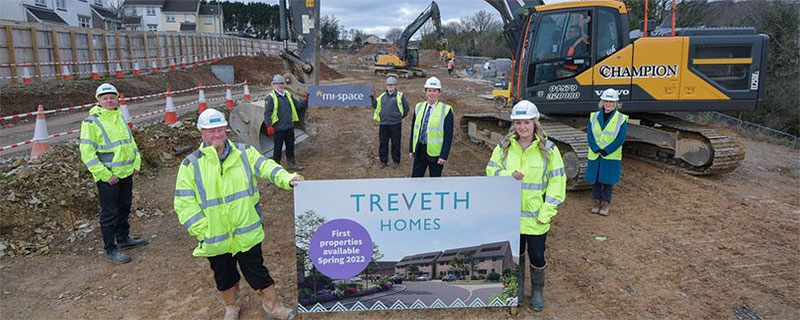The commencement of work at the Maudlin Farm site in Liskeard, Cornwall,
just one of the sites with a question mark hanging over it’s completion
Despite calls upon the government to intervene and, later, attempts to sell the business, the South West construction firm Midas collapsed into administration last week.
The collapse of the business has led to over 300 redundancies, though it is understood that a section of the business (Mi-Space) has been sold, saving over 50 jobs. Concerns have also been raised about the knock-on effort on sub-contractors and connected businesses, many of whom have been left out of pocket through unfulfilled contracts and unpaid invoices.
The collapse of any business is always disappointing to read about and in this case is consistent with the latest insolvency statistics relating to the construction industry. The statistics, released by the Insolvency Service for Q4 of 2021, evidence a significant increase in insolvencies for the sector as compared with 2020.
Increases in insolvencies were seen across the majority of industries in 2021 compared to 2020. However, construction was one of a number of sectors showed increases above the overall annual increase of 11%, at 25%. Furthermore, as standalone figures, construction was the industry which experienced the highest number of insolvencies (2,579). By way of comparison, wholesale and retail trade and repair of vehicles experienced 1,722 insolvencies, and accommodation and food services activities experienced 1,673 insolvencies.
It is understood that blame is being placed on the pandemic, shortages of materials and labour and a significant rise in costs caused by inflation. These could all have a significant impact on the cost and programme for construction projects, and the allocation of this risk should be carefully considered by parties when negotiating the building contract terms. We may also see parties re-negotiating building contracts for distressed projects, if the contractor’s insolvency would ultimately lead to higher costs and delays than allowing short-term financial relief.
There may be some hope on the material shortage front as this seems to have been easing since the end of 2021. However the reprieve may be short-lived as soaring energy costs could lead to a higher cost of some energy heavy materials, such as concrete and steel. The next year will bring a lot of uncertainty for the construction industry, with many companies likely to have a stronger focus on efficiency. As a result we may see significant growth in areas such as off-site manufacturing and sustainable construction.
Source: Lexology
The collapse leaves unfinished housing projects that will now become part of the administration of the Midas Group, leaving questions about who will complete the work and when.
However bosses at the failed firm seem to have faired better. It seems one was paid more than half a million pounds while the company was making huge losses.
Accounts for the stricken firm, show the highest-paid director trousered £504,000 in the 18 months to the end of October 2020.
This sum does not include pension contributions so it is likely the director benefited further.
The payment was made in the same 18 months when the company made an after-tax loss of more than £2m.
The highest paid director also pocketed £443,000 in 2019, the group’s annual report and financial statements reveal.
In total, directors were paid £1,869,000 during the 18 months to the end of October 2020, with £53,000 paid in pension contributions.
At the time the directors were chairman Steve Hindley, chief executive Alan Hope, Mike Hocking, and chief commercial officer Scott Poulter, plus finance director Duncan Rogerson, who resigned in July 2019 and was replaced by Michael Ready.
Mr Ready left the company in March 2021 to move to Australia and was replaced by Peter Skoulding.







Leave a Reply
Want to join the discussion?Feel free to contribute!